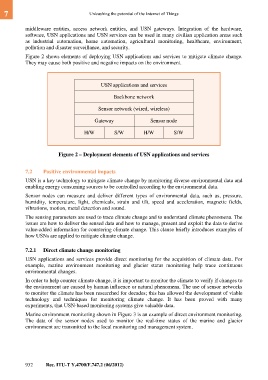Page 946 - Unleashing the potenti al of the Internet of Things
P. 946
7 Unleashing the potential of the Internet of Things
middleware entities, access network entities, and USN gateways. Integration of the hardware,
software, USN applications and USN services can be used in many civilian application areas such
as industrial automation, home automation, agricultural monitoring, healthcare, environment,
pollution and disaster surveillance, and security.
Figure 2 shows elements of deploying USN applications and services to mitigate climate change.
They may cause both positive and negative impacts on the environment.
USN applications and services
Backbone network
Sensor network (wired, wireless)
Gateway Sensor node
H/W S/W H/W S/W
Figure 2 – Deployment elements of USN applications and services
7.2 Positive environmental impacts
USN is a key technology to mitigate climate change by monitoring diverse environmental data and
enabling energy consuming sources to be controlled according to the environmental data.
Sensor nodes can measure and deliver different types of environmental data, such as, pressure,
humidity, temperature, light, chemicals, strain and tilt, speed and acceleration, magnetic fields,
vibrations, motion, metal detection and sound.
The sensing parameters are used to trace climate change and to understand climate phenomena. The
issues are how to deliver the sensed data and how to manage, present and exploit the data to derive
value-added information for countering climate change. This clause briefly introduces examples of
how USNs are applied to mitigate climate change.
7.2.1 Direct climate change monitoring
USN applications and services provide direct monitoring for the acquisition of climate data. For
example, marine environment monitoring and glacier status monitoring help trace continuous
environmental changes.
In order to help counter climate change, it is important to monitor the climate to verify if changes to
the environment are caused by human influence or natural phenomena. The use of sensor networks
to monitor the climate has been researched for decades; this has allowed the development of viable
technology and techniques for monitoring climate change. It has been proved with many
experiments, that USN-based monitoring systems give valuable data.
Marine environment monitoring shown in Figure 3 is an example of direct environment monitoring.
The data of the sensor nodes used to monitor the real-time status of the marine and glacier
environment are transmitted to the local monitoring and management system.
932 Rec. ITU-T Y.4700/F.747.2 (06/2012)

